The Shining and the Steadicam®: an interview with inventor Garrett Brown
LOOK OUT!
Captivated by innovation and storytelling as a child, Garrett Brown was many things—folk singer, car dealer, copywriter, radio personality—before he invented the Steadicam and Skycam, whose stable, gliding shots have captivated movie and television audiences ever since. At 78, with more than 50 patents, 70 films, an Oscar, and an Emmy to his name—among other impressive awards and honors—he is still inventing, this time on what could be a revolutionary new alternative to walkers and wheelchairs.
17 min read
Each month, our Journeys of Innovation series tells the stories of inventors or entrepreneurs whose groundbreaking innovations have made a positive difference in the world. This month’s story focuses on the journey of 2013 National Inventors Hall of Fame inductee Garrett Brown.

One day in late 1974, Garrett Brown and his attorney, Gerard Weiser, sat down to meet with a patent examiner named Monroe Hayes in the Crystal City neighborhood of Arlington, Virginia. Hayes had agreed to the appointment so Brown and Weiser could argue the case for their patent application, filed on September 16 of that year, for “equipment for use with hand held motion picture cameras.” The “Brown Stabilizer,” as the 32-year-old Brown then called his invention, was an odd looking contraption, described as “a pair of interconnected spring loaded arms, one end of which is pivotally supported by a carrying brace worn by a camera operator and the other end of which is connected to a handle positioned to mount the camera equipment at approximately the center of the moment of inertia.”
In essence the way it worked, the application explained, was that the camera and associated equipment were mounted in “exploded, balanced relation about the handle” with the weight of the camera equipment “substantially counterbalanced by the action of the spring loaded arms without employing counterweights.” What this meant, in more practical terms, was that a camera operator to whom it was harnessed could walk, run, and generally move around at will while the camera itself remained completely stabilized, unaffected by the motions of the operator.
Weiser asked if Brown could provide a demonstration with the prototype he had brought along, and a skeptical Hayes agreed.
After harnessing up, “I thundered down the long corridor and back again,” recalls Brown, who at 6’6” made quite an impression running through the normally quiet halls of the U.S. Patent Office,1 “and each time more doors opened and dozens of examiners dusty faces peered out to watch the camera flying weightless and level as if on rails.” Soon a number of those examiners had crowded into Hayes’s office to study the Brown Stabilizer, which had evolved from earlier prototypes with less promising nicknames like the Pole, the CineTurkey, and even the BELCH (Brown Effect Level Camera Holder).
A suitably impressed Hayes allowed all of the application’s 124 claims, and Brown eventually received his patent on April 12, 1977. By then the Steadicam, as it was now known (and officially trademarked on October 2, 1979), had completely revolutionized the way films were shot—as no less an authority than director Stanley Kubrick predicted it would.
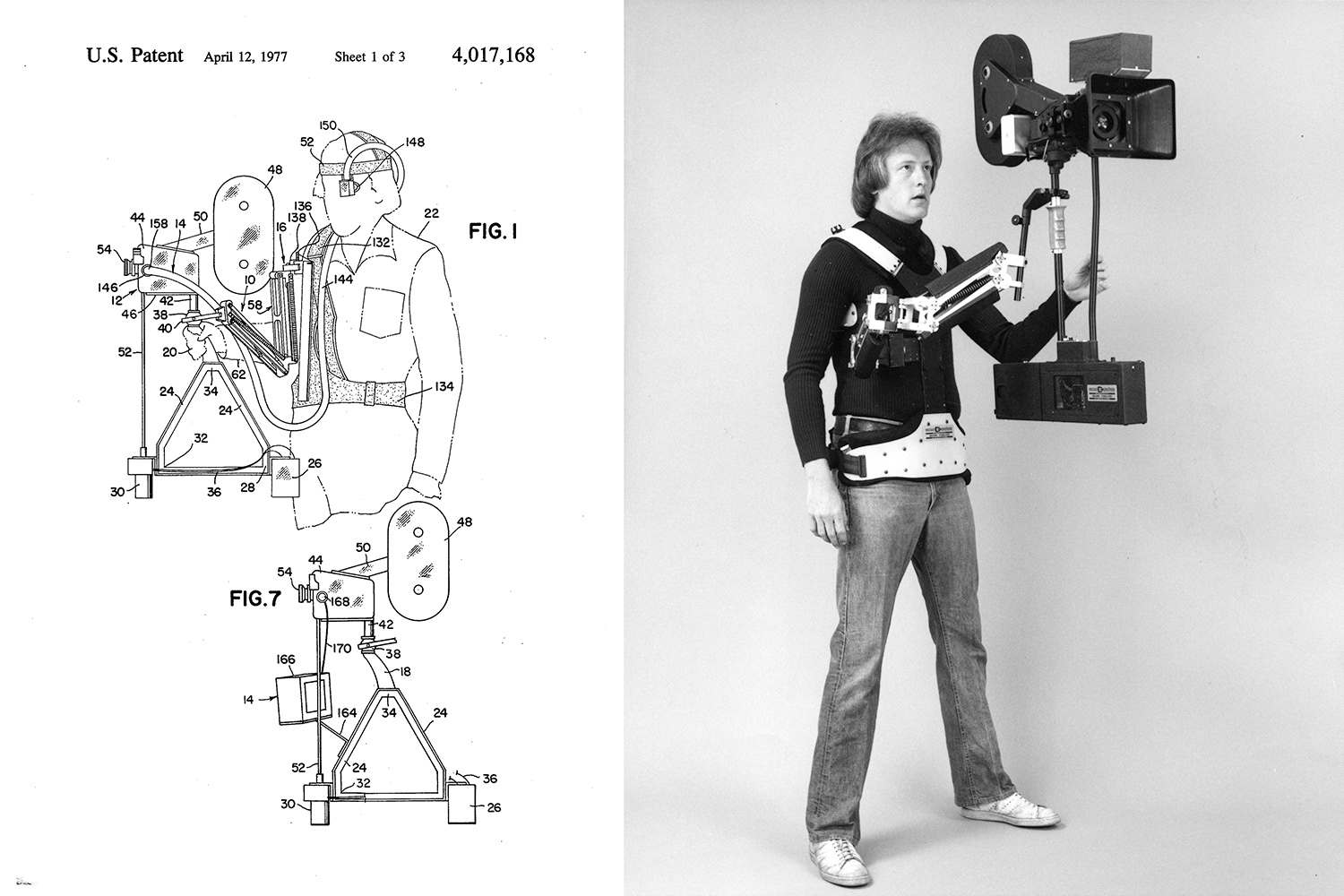
U.S. Patent No. 4,017,168, left, for “equipment for use with hand held motion picture cameras,” depicts a camera operator who looks suspiciously like its inventor, Garrett Brown, right. Brown, who in 1974 ran down a hallway of the U.S. Patent Office to demonstrate how the “Brown Stabilizer” worked, trademarked it as the Steadicam on October 2, 1979 (U.S. Trademark No. 1,125,516).
In hindsight, Brown seemed almost fated to invent. Born in Long Branch, New Jersey, and raised in Havertown, Pennsylvania, he was the first of three children born to Rodney G. Brown, a chemist at DuPont, and Fannie Rachel Wood, an English school teacher. In 1946, when Brown was 4, his father invented the industry-changing “hot melt” adhesives that have bound magazines and paperback books ever since, allowing for much faster printing and a longer-lasting binding. While Fannie influenced Brown’s interest in art, his father—who would bring home “broadsides,” or advertisements of General Electric’s famous inventors—encouraged his interest in more technical pursuits.
“My dad talked up inventing,” Brown recalls. “He was a big fan of [Charles] Steinmetz and obviously Edison.”
“There was an atmosphere of discussing science in our house.”
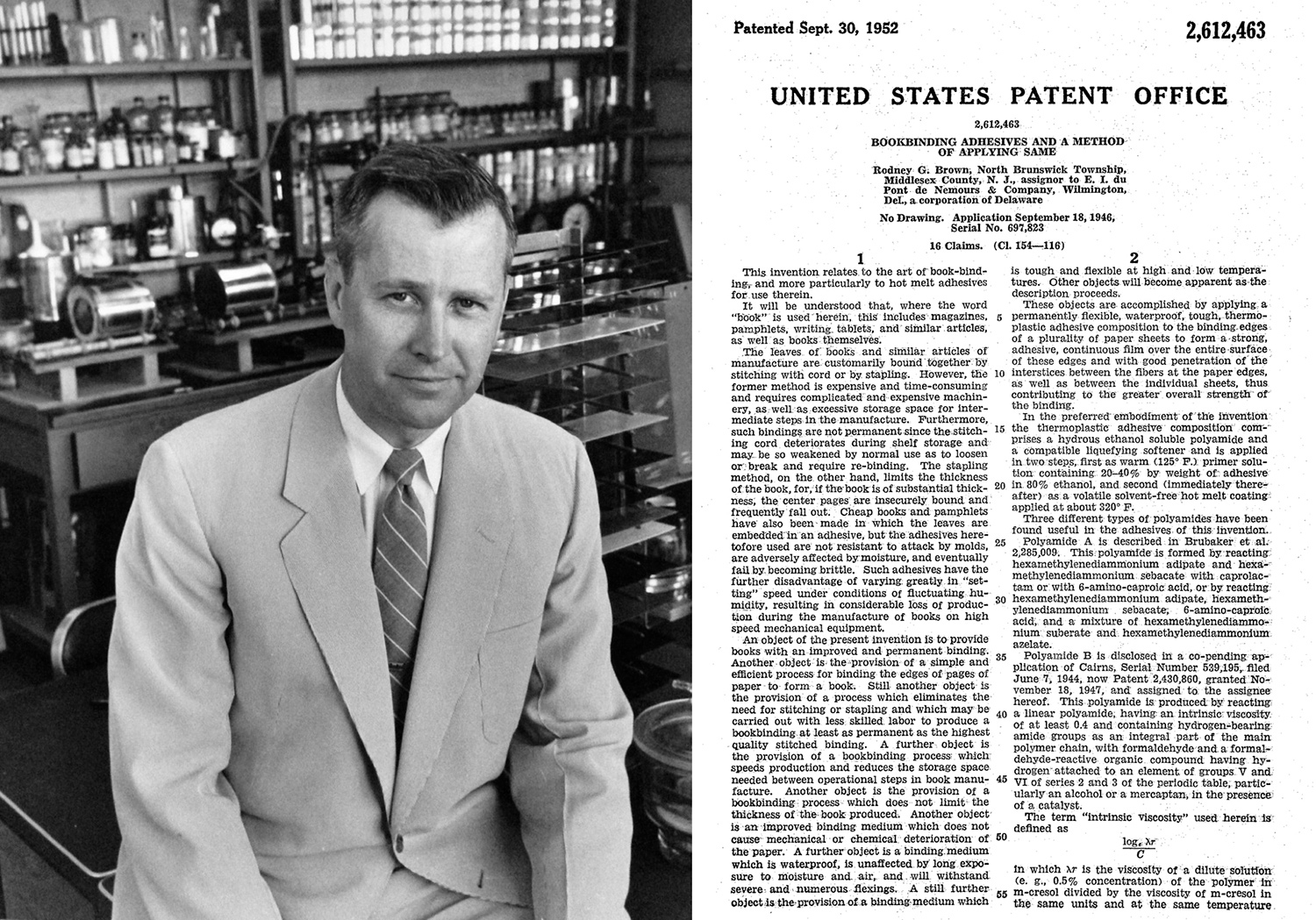
“My dad talked up inventing,” says Brown of his father, Rodney G. Brown, left, who received U.S. Patent No. 2,612,463 in 1952 for his invention of “hot melt” adhesives, a dramatic improvement on existing animal-based glues for binding magazines and paperback books.
Brown’s father gave him first a chemistry set—“I was a dangerous sort of chemist kid, just randomly … trying to get things to explode”—and later an Erector Set, which was more to Brown’s liking. He was also deeply influenced by books like William Meadowcraft’s “The Boy’s Life of Edison,” another gift from his father, and “Twenty Thousand Leagues Under the Sea” by Jules Verne, whose exotic tale of Captain Nemo—inventor of his own electric-powered submarine, underwater diving suits, and air guns—stimulated Brown’s already active imagination. In fact the idea of calling his first invention the Brown Stabilizer, more than two decades later, was inspired by the “Ruhmkorff apparatus” Nemo used for underwater lighting.
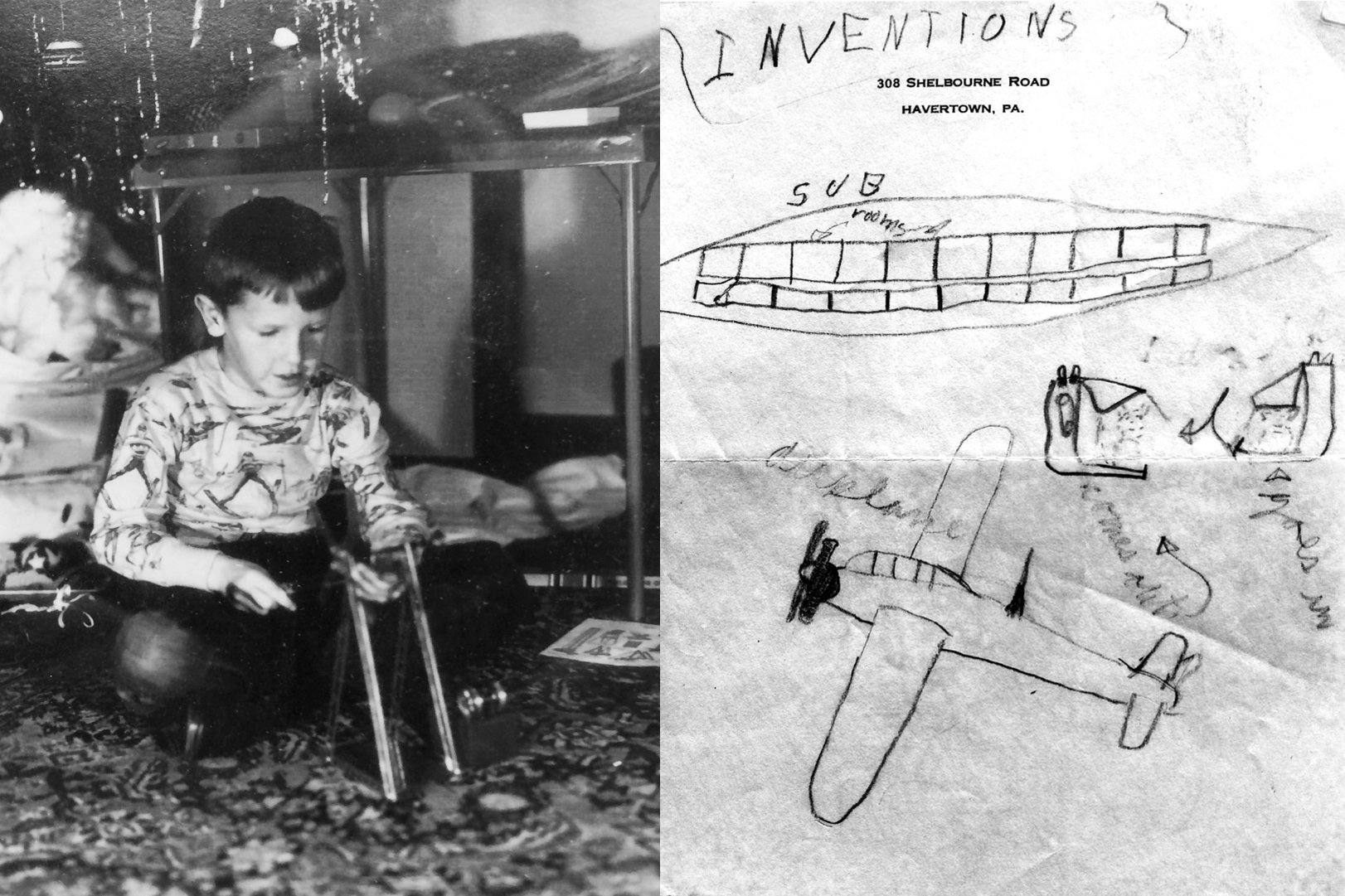
“I was a dangerous sort of chemist kid, just randomly … trying to get things to explode,” recalls Brown, seen here with an Erector Set more to his liking. His early childhood drawing of a submarine and airplane, titled “Inventions,” foreshadowed what would become a lifelong passion for innovation.
But like the voyages of Nemo's famous, if fictitious submarine the Nautilus, Brown’s life took a number of improbable turns in the years before his first patent and the storied career that followed. In spite of his father’s influence and Brown’s early love of invention, he had no clear idea of what he wanted to do after high school. The recipient of a Navy Reserve Officers Training Corps (ROTC) scholarship, he was accepted to Tufts and Harvard universities, chose Tufts, but soon intentionally flunked out of college to pursue a brief, but happy stint as a folk singer, “much to his [father’s] disgust.” Over the course of three years, he performed at some 300 college concerts and clocked over 100,000 miles in his Pontiac Bonneville convertible.
“It was the most fun you can imagine,” he recalls.
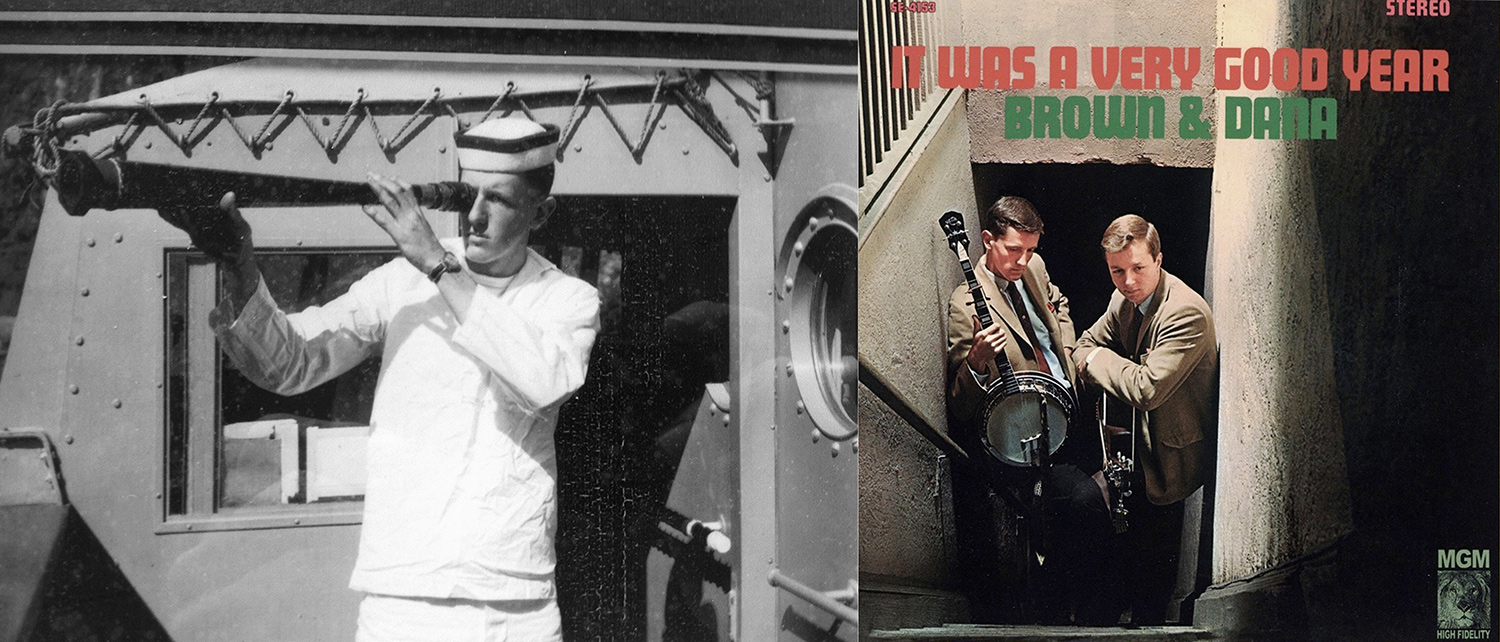
Brown, who was accepted to Tufts University on a Navy ROTC scholarship, chose instead to flunk out of school and spend three years as a touring folk singer. “It was the most fun you can imagine,” he recalls. He and Al Dana released their album “It Was a Very Good Year” on MGM in 1963.
But a lifelong career in folk singing wasn’t to be, so Brown tried his hand at writing while working as a Volkswagen salesman. When he sold his first story—a science fiction tale, naturally—he quit his job only to realize that he couldn’t make enough money writing short stories. He took up copywriting instead, at a medium-sized ad agency, which in turn led to doing ad-libbed radio ads, a good fit for a natural storyteller with a lively sense of humor. In the meantime, a friend had loaned him a Bolex film camera. It was at this point in his life that Brown’s personal journey as an inventor began to take off.
A keen fan of movies, he was drawn to the technical side of moviemaking and spent hours reading everything he could about it at the Philadelphia Public Library. None of the film companies in town would hire him, since he had no experience to speak of, so with friend Warren Paul he started the Moving & Talking Picture Company of Philadelphia, New York, and Gradyville, working mainly on commercials for banks, car dealers, and insurance companies. Their work soon acquainted Brown with the two most daunting challenges of cinematography up to that time: the extraordinary bulkiness of the gear and the inability to capture steady, moving shots.
“I loved moving the camera, and my way of doing that was the ancient way, with ... a gigantic [800-pound] dolly and five crappy sections of rail I would lay if I wanted to dolly outside, because you could not make a smooth move with a camera in that era—think back, it’s hard to imagine—without a dolly, a camera car, or a crane.”
As his father had 30 years earlier when confronting the problem of book and magazine binding, Brown set out to invent a solution, creating and experimenting with numerous prototypes—the first had been a simple pole with a weighted T-bar at the back, cobbled out of plumbing pipe and lead ingots—before he finally came up with the right one that could bear the weight of a typical, 1970s-era 35mm film camera. It came to him not in a sudden “eureka moment,” but as the product of “a desperate seven-day marathon of thinking,” alone in a room at the West Chester Holiday Inn, from which he emerged at last with a sketch and a crude model of the Steadicam arm cobbled together from lamp parts.
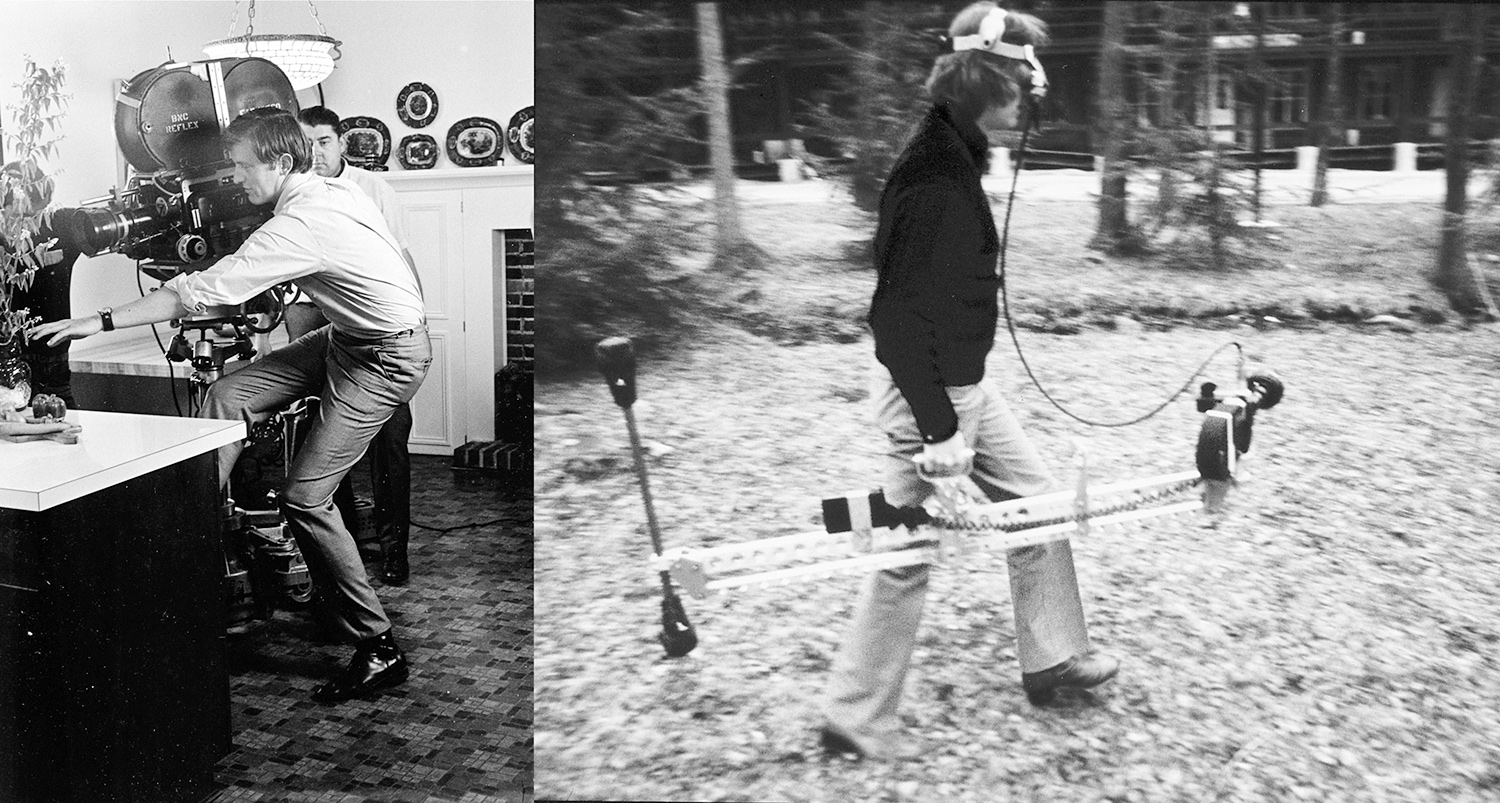
At left is Brown behind the lens of one of the extremely heavy film cameras he used on productions before his later inventions. At right he holds an early prototype of the handheld camera stabilization system he alternately called the Pole, the CineTurkey, and even the BELCH (Brown Effect Level Camera Holder) before settling on the Steadicam.
“In truth I was quite let down,” Brown later wrote. “The thing would probably support a 35mm camera but my weary imagination balked at the complexities of building the arm and I doubted it would ever give the dolly much competition. At best it would be simpler and smaller than the crane and perhaps acceptable for certain kinds of fast-moving shots.” Nevertheless, he resolved to go for broke and build one last prototype, with which he and his friends shot a test reel of “30 impossible shots” in and around Philadelphia, including one of his filmmaking partner and later wife, Ellen Shire, running up and down the steps in front of the Museum of Art, pursued by Brown and his stabilized camera. While shopping the test reel around Los Angeles and gauging the reaction of Hollywood filmmakers, Brown soon realized that his work was done. He had succeeded. That final prototype worked almost “exactly like the Steadicam still works today. ... Somewhere near the end of that endless week [alone in the hotel room], the structural requirements that became [U.S. Patent No. 4,017,168] were set down.”
Among the prominent directors who expressed immediate interest in Brown’s invention were Stanley Kubrick, who swore it would “revolutionize the way films are shot,” and John Avildsen, who was preparing to direct a film called “Rocky.”
“Where are those steps, and how did you do that?” Avildsen wanted to know.
A few months later, in 1975, Brown was back at the Philadelphia Museum of Art filming a young Sylvester Stallone running up the same steps Ellen had, for what became the most memorable scene of the movie. But “Rocky” wasn’t the first film Brown worked on with the Steadicam; that honor went to “Bound for Glory,” directed by Hal Ashby and starring David Carradine as Woody Guthrie.
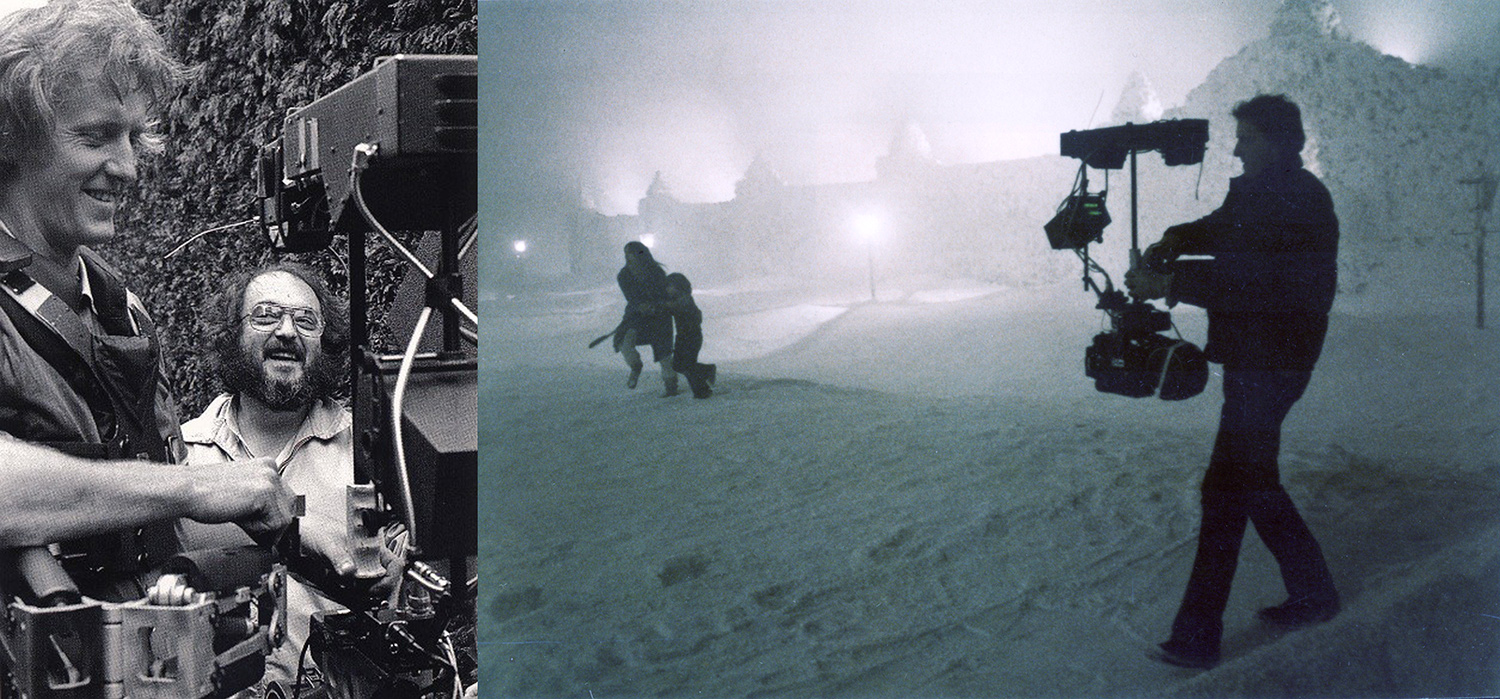
“The Shining” director Stanley Kubrick, left, famously predicted that the Steadicam would “revolutionize the way films are shot.” At right, Brown films actress Shelley Duvall and actor Danny Lloyd fleeing Jack Nicholson on the set of the movie’s Overlook Hotel.
“I had never been on a feature set until I arrived in Stockton, California, and entered Ashby’s enormous migrant worker camp with 900 extras,” Brown would later recall. Nor had he ever seen a Chapman Titan Crane before, from which he was expected to film one of the movie’s longest shots, starting from 30 feet in the air.
At one point during the rehearsals, the surprised crane operator looked up at Brown, who was shaking with fear, and said, “That’s funny, the camera isn’t shaking!”
“As the crane boomed down beside David Carradine,” Brown recalled of the three four-minute takes he then shot, “I got off and ‘walked’ with him across the huge camp and most of the way back, dodging kids and crowds and tent ropes and vehicles. In the end, I was numb with fatigue and nerves, and the whole crew flowed away to resume the regular work without a backward glance.”
“It was two nights later (just after asking the producer if he was the projectionist!), that I finally saw our amazing shot and received a standing ovation (with real clapping and real standing!) from the large crowd in the screening room.”
That historic shot, for which Brown was later recognized with an award from the Society of Camera Operators, helped garner “Bound for Glory” an Academy Award for Best Cinematography. It also put Brown and his Steadicam in very high demand. Over the next five years alone he worked on more than 25 movies, including other hits like “Marathon Man,” “Rocky II,” “Stripes,” and “Taps.” Among the most memorable and technically challenging scenes he shot during that time were those for “The Shining,” including an extended, floor-level shot of child actor Danny Lloyd riding his Big Wheel through the hallways of the Overlook Hotel set.
“We had to invent ways of doing it,” says Brown, who discovered that by flipping the Steadicam and the camera upside down, they could film shots in “low mode” from below the knees to above the waist. What they needed next to achieve the “eerie smoothness” director Stanley Kubrick wanted was a “vehicle” to carry Brown and his Steadicam behind Lloyd through the hallways.
“The winning object was a wheelchair that Kubrick had had made for himself so that he could be wheeled along shooting hand-held. ... I managed to hard-mount the low-mode Steadicam on that so the lens was one inch above the floor, which is a stunning, wonderful place for that lens.”
“That film cemented the usefulness of the Steadicam for all time,” says Brown. “That film is where I learned my trade.”
By then Brown was already the recipient of an Oscar himself, presented to him at the 50th Academy Awards in 1978, by actor Billy Dee Williams, as a “special scientific and technical award for the invention and development of Steadicam.” Over the years Brown would film many other iconic scenes, including Harrison Ford on the rope bridge in “Indiana Jones and the Temple of Doom” and the speeder bike chase in “Return of the Jedi.” Today he is credited with work on more than 70 movies, including “Bulworth,” on which he and his son Jonathan—who has since become a film director himself—were both Steadicam operators.
Brown’s personal journey of innovation, however, did not end with the Steadicam; incredibly, it was only just beginning. In 1979, while working on an episode of “Little House on the Prairie,” a conversation with actor Merlin Olsen about the impossibility of certain camera angles planted the seeds of an idea that would lead to a simple experiment in Brown’s kitchen at home. With nothing but a quarter-inch bolt and yards of sewing thread tied to various points in his kitchen, he discovered that he could move the bolt to almost any position he wanted just by taking up or letting out the threads.
Inspired, he raised the money to build and test a prototype “flying camera” that would be suspended by cables and remote-controlled to provide long, sweeping shots over an event like a football game. The early experiments were “startlingly smooth, but glitchy.” After working out the wrinkles Brown successfully debuted his “flying camera” in 1984, at a preseason NFL match between the San Diego Chargers and San Francisco 49ers, and again in the 1985 Orange Bowl. Soon his latest invention was being used to film not only football games, but other sports like skiing as well as movies, commercials, and even music videos. Brown filed his patent application on July 30, 1985. Less than two years later, on December 1, 1987, he received a patent for his “suspension system for supporting and conveying equipment, such as a camera”—or “Skycam” as it was officially trademarked on February 12, 1991.
“The wonderful thing about Skycam,” says Brown, “is that it let you put a lens where no camera could ever go before.”
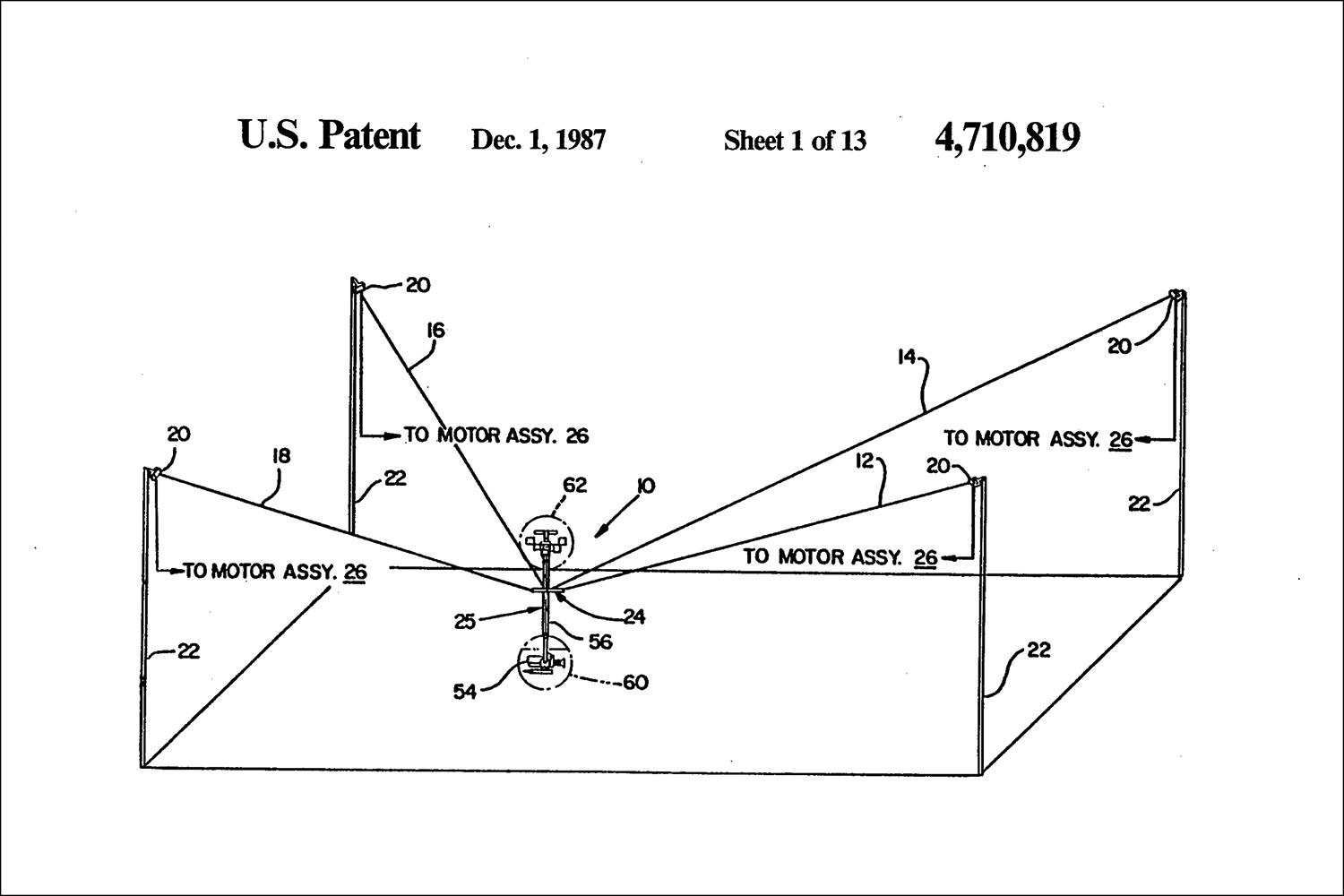
Within 10 years of patenting the Steadicam, Brown received U.S. Patent No. 4,710,819 for an aerial camera suspension and conveyance system known as the Skycam (U.S. Trademark No. 1,634,708), which dramatically changed the way major sporting events were shot.
That same creative urge to put cameras in new places, as he had done in “The Shining,” and a growing demand for his unique talents in the sports and entertainment industries, led Brown to invent the MobyCam, a submarine tracking camera system custom-designed to film swimmers for the 1992 Summer Olympics; the DiveCam, a gravity-powered, vertical camera tracking system custom-designed to film divers for the 1996 Summer Olympics; and the FlyCam, an ultralight, high-speed, aerial stabilized tracking camera system first invented to film a Papal visit to Mexico City in 1998, but later used to film sporting events and concerts as well. Brown also invented several improvements to the Steadicam, including the Steadicam Merlin, an ultralight, ultra-compact, next-generation version of its predecessor, and the Steadicam Tango, a Steadicam accessory for floor-to-ceiling boom range.
Today Brown owns more than 50 patents for these innovations and several others. Among the many awards and tributes for his contributions to cinematography, he received a Scientific and Engineering Award from the Academy of Motion Picture Arts and Sciences in 2006, for the invention of the Skycam; induction into the National Inventors Hall of Fame in 2013, for his invention of the Steadicam; and a Charles F. Jenkins Lifetime Achievement Award at the Television Academy’s 67th Engineering Emmy Awards in 2015, noting that Brown’s “continuous invention of camera-stabilization products and techniques has changed the visual language of filmed storytelling.”
Kubrick, it turns out, was only partly right. Garrett Brown didn’t just revolutionize the way films were shot; he revolutionized the way everything was shot.

Garrett Brown at the Exokinetics factory in West Chester, Pennsylvania. (Photo by Jay Premack/USPTO)
“I am more convinced than ever that invention is a habit,” says Brown, who at 78 has lost none of his passion for inventing. When he isn’t traveling around the world with his wife Ellen, speaking at workshops and conferences on invention or filmmaking, he is often hard at work on the second floor of his barn—which sits on 10 acres of wooded, Pennsylvanian hillside—tinkering with tools and random mechanical parts in what might appear to the casual visitor to be a mad scientist’s lab.
“I’m not a very well organized inventor,” Brown confesses. “I was a ‘scattered’ kid as they used to say, before they diagnosed ADHD, or ADD. But scattered is okay, because us scattered kids can sometimes concentrate very fiercely on stuff, and this is the place where my relics reside from 50 years of work as a cameraman and inventor ... a place where I can come to think about stuff and try experiments.”
“I would never suggest that anyone invent for money, because that is a hazardous undertaking,” says Brown. “If I invent something, it’s because I want something that isn’t there.”
Indeed, he continues to invent whenever and wherever he discovers a need for something, like “an attractive support arm that can instantly position iPads and other tablets to show visual media in bedrooms or boardrooms to viewers who are standing, seated or reclining—and silently re-orient its screen to share (or restrict) the view in any direction.” The idea came to him while trying to read his own tablet in bed at night. And like his childhood inspiration, Captain Nemo, he even has a custom-built vessel he designed himself—not a submarine, but a 36’ sailboat on the Eastern Shore of the Chesapeake, “full of inventions.”
But the main focus of Brown’s enthusiasm and inventive drive in recent years is something with a far wider and more beneficial application, no less revolutionary in its potential than the Steadicam and Skycam were. In a way the inspiration for it came to him from the same two people who nurtured his curiosity and creativity from the very beginning: his father Rodney, who lived to be 97, and his mother Fannie, who is still alive and well at the astonishing age of 107.
“As he was declining gracefully,” Brown says of his father, “I hung out with him, and I looked at his cohort on walkers and wheelchairs, and I did not admire either object. A walker is kind of demeaning, and a wheelchair is a one-way ticket to not walking.”
“What could you do,” he wondered, “that was not a walker, was not a wheelchair, but that allowed you to move and walk and stay ambulatory safely, so you couldn’t fall?”
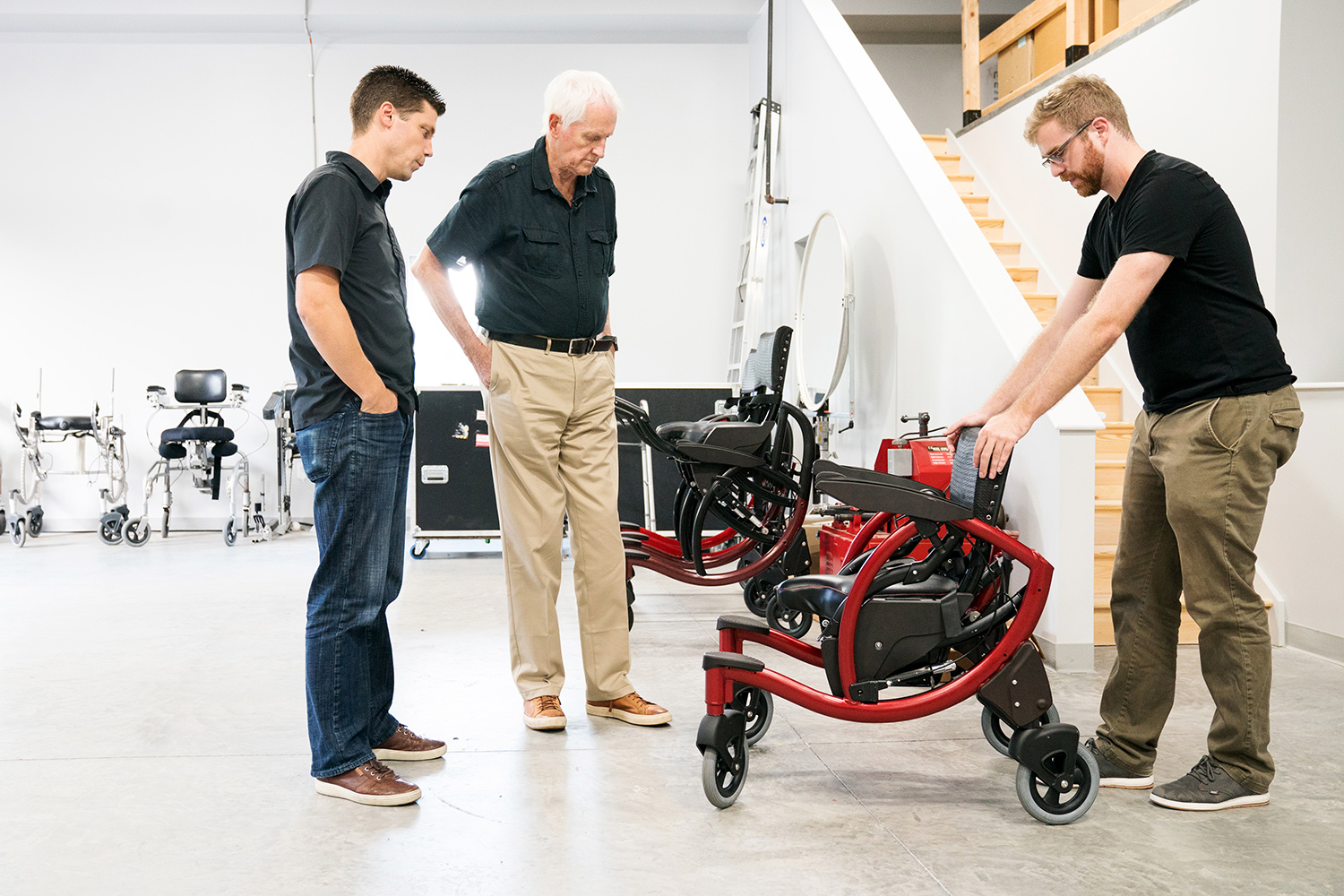
Garrett Brown, center, discusses modifications to the most recent iteration of the Zeen, an advanced mobility device, with engineering director Ryan Meers, left, and associate mechanical engineer, Daniel Lefebvre, right, at the Exokinetics factory in West Chester, Pennsylvania. (Photo by Jay Premack/USPTO)
The idea he and co-inventor Chris Fawcett came up with about six years ago was something they called “the Zeen,” after an early 19th-century precursor to the bicycle known as the ”Draisine.” Essentially an elevated walker-chair, the Zeen allows the person using it to “rise up and sit down effortlessly and transition to walking or coasting seamlessly, without concern for falls”—enabling them not only to get around comfortably but to perform a variety of ordinary tasks, like cooking and cleaning, all while maintaining their cardiac, circulatory, and muscular health rather than degrading it, as inevitably happens when consigned to a wheelchair. Like Brown’s earlier inventions, the Zeen evolved through lots of trial and error, and over a series of increasingly lighter, more effective, and more easily collapsible prototypes, until arriving at the current one.
“It weighs just north of 30 pounds at the moment, and we’ll get it a bit lighter,” he says, after demonstrating its many modes of mobility and repose around the floor of the West Chester shop where he and his team at Exokinetics—the company he co-founded with Fawcett—plan to soon manufacture beta versions of the Zeen on demand, through online orders, and eventually for dealers around the world.
“This one has come a long way. It’s kind of thrilling, actually.”
Will the Zeen be a commercial success, making walkers and wheelchairs increasingly obsolete? It’s a tantalizing question one can’t help but ask after seeing the inevitable smile of delight on an elderly test subject who tries out a Zeen for the first time.
“I’m conscious of the odds against any new invention succeeding,” says Brown, whose lifelong habit of invention has produced more than its fair share of wonders already, “but if this one does succeed: Look out.”
Endnotes
1 Public Law 93-596 officially changed the agency’s name to “Patent and Trademark Office” on January 2, 1975.
Credits
Produced by the USPTO Office of the Chief Communications Officer. For feedback or questions, please contact inventorstories@uspto.gov.
Image on USPTO homepage and at top of story: Surrounded by various versions of the Zeen, Garrett Brown sits on the Gamma, the current iteration his invention, at the Exokinetics factory in West Chester, Pennsylvania. (Photo by Jay Premack/USPTO)
All images courtesy of Garrett Brown unless otherwise noted in the captions.
Story by Eric Atkisson. Additional contributions from Jay Premack, Rebecca Fritchman, and Marie Ladino.
References
”EG4 Garrett Brown, Steadicam Inventor.” EG Conference. January 30, 2011. Video, 25:33. www.youtube.com/watch?v=iY90-mzJUOo.
Exokinetics. www.exokinetics.com.
Garrett Brown: Filmmaker and Inventor. www.garrettcam.com/.
”Garrett Brown on Inventing the Steadicam and the Arm.” Television Academy Foundation, The Interviews. Video, 56:30. interviews.televisionacademy.com/interviews/garrett-brown.
”Inventor Garrett Brown on Why He Invents.” TelevisionAcademy.com/Interviews. July 31, 2018. Video, 1:10. www.youtube.com/watch?v=5xpccoU6ocA.
Pennington, Adrian. ”Industry Innovators: Garrett Brown.” January 14, 2020. www.ibc.org/interviews/industry-innovators-garrett-brown/5338.article.
Sims, Gayle Ronan. ”Gerard J. Weiser, 82, Patent Lawyer.” Philadelphia Inquirer. March 29, 2008. www.inquirer.com/philly/obituaries/20080329_Gerard_J__Weiser__82__patent_lawyer.html.
SteadiShots.org: a Tribute and Study of Steadicam Operators and Their Work. www.steadishots.org/.
Television Academy. ”Television Academy Names Honorees for 67th Emmy Engineering Awards.” September 29, 2015. www.emmys.com/news/awards-news/television-academy-names-honorees-67th-emmy-engineering-awards.
Wong, Eddie. ”Garrett Brown’s SkyCam History.” vocal.media/futurism/garrett-brown-s-skycam-history.





